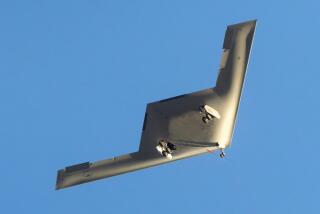Skunk Works: Developing top-secret weapons in SoCal for 70 years
Few places in the aerospace industry are as revered as Lockheed Martin Corp.’s Skunk Works.
For decades, employees at the secretive site have designed and built the some of the most innovative military aircraft ever built.
The U-2 spy plane. The SR-71 Blackbird. The F-117 Nighthawk.
This week, the shadowy weapons development facility in Palmdale silently celebrated its 70th anniversary. It should come as no surprise that the milestone came with little fanfare, considering the Skunk Works mantra is “quick, quiet and quality.”
About 90% of all the work at the facility is classified. Most projects are so secret that employees can’t tell one another what they’re working on inside the windowless white building in the Mojave Desert that’s surrounded by tiers of razor-wire fences.
Lockheed has said that about 2,000 people work on 600 programs in the Advanced Development Programs division, more commonly known as Skunk Works.
It got its nickname in 1943 at its original Burbank headquarters, which was located next to a manufacturing plant that produced a strong odor.
At the time, a worker jokingly called the facility “Skunk Works,” a reference to a remote location in the popular comic strip “Li’l Abner,” where a hermetic character brewed a foul concoction from worn shoes and dead skunks.
The name stuck. Skunk Works employees are now called “skunks” and Alton D. Romig Jr., now the general manager of the division, is known as “chief skunk.”
The first project was to build the first American combat-ready fighter jet that could defeat the German Lufftwaffe, which already developed a jet-powered aircraft.
Skunk Works founder Clarence “Kelly” L. Johnson and his team of young engineers delivered the XP-80 Shooting Star to the U.S. Army’s Air Tactical Service Command in only 143 days, seven less than was required.
The high-flying U-2 spy plane was first designed during the Eisenhower administration to breach the Iron Curtain and, as engineers said, snap “picture postcards for Ike” of hidden military strongholds in the Soviet Union. The jet still flies today.
The SR-71 Blackbird flew reconnaissance missions starting in 1966 at speeds exceeding Mach 3 and altitudes of 85,000 feet. The last SR-71 mission was in the spring of 1995.
It remains a technological marvel. On Sept. 1, 1974, an SR-71 flew from New York to London in 1 hour, 54 minutes, 56 seconds. It beat the previous trans-Atlantic speed record by nearly three hours.
Skunk Works also built the F-117 Nighthawk, the world’s first radar-evading aircraft, which attacked the most heavily fortified targets in Iraq during Desert Storm in 1991. It was the only coalition jet allowed to strike targets inside Baghdad’s city limits.
Since then, engineers at Skunk Works have designed the prototypes that would become the F-22 and F-35 fighter jets.
More recently, their bat-winged RQ-170 Sentinel drone’s capabilities were demonstrated during the raid on Osama bin Laden’s compound in Pakistan, where it provided surveillance of the operation. The drone later crashed in Iran while on a CIA surveillance mission.
Skunk Works is so well-known that it has become a common term to describe a group within a business that works on advanced or secret projects.
ALSO:
F-35 fighter jet struggles to take off
How I Made It: SpaceX exec Gwynne Shotwell
F-22 program produces few planes, soaring costs
More to Read
Inside the business of entertainment
The Wide Shot brings you news, analysis and insights on everything from streaming wars to production — and what it all means for the future.
You may occasionally receive promotional content from the Los Angeles Times.











